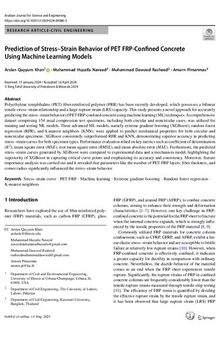 جزییات کتاب
جزییات کتاب
Polyethylene terephthalate (PET) fiber-reinforced polymer (FRR) has been recently developed, which possesses a bilinear tensile stress–strain relationship and a large rupture strain (LRS) capacity. This study presents a novel approach for accurately predictingthestress–strainbehaviorofPETFRP-confinedconcreteusingmachinelearning(ML)techniques.Acomprehensive dataset comprising 154 axial compression test specimens, including both circular and noncircular cases, was utilized for training and testing ML models. Three advanced ML models, namely extreme gradient boosting (XGBoost), random forest regression (RFR), and k-nearest neighbors (KNN), were applied to predict mechanical properties for both circular and noncircular specimens. XGBoost consistently outperformed RFR and KNN, demonstrating superior accuracy in predicting stress–strain curves for both specimen types. Performance evaluation relied on key metrics such as coefficient of determination (R2), mean square error (MSE), root mean square error (RMSE), and mean absolute error (MAE). Furthermore, the predicted stress–strain curves generated by XGBoost were compared to experimental data and a mechanism model, highlighting the superiority of XGBoost in capturing critical curve points and emphasizing its accuracy and consistency. Moreover, feature importance analysis was carried out and it revealed that parameters like the number of PET FRP layers, fiber thickness, and corner radius significantly influenced the stress–strain behavior.



 دانلود کتاب
دانلود کتاب

 جزییات کتاب
جزییات کتاب





 این کتاب رو مطالعه کردید؟ نظر شما چیست؟
این کتاب رو مطالعه کردید؟ نظر شما چیست؟
